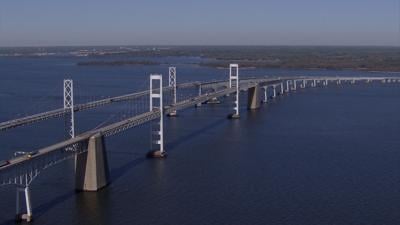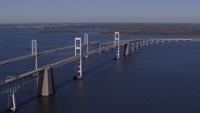QUEEN ANNE'S, Md. -- The National Transportation Safety Board cited 68 bridges in 19 states needing urgent repair. The Chesapeake Bay Bridge made the list, prompting the Maryland Department of Transportation to craft a quick response.
In 1991, the American Association of State Highway and Transportation Officials, or AASHTO, created the vulnerability assessment for bridges. The test helps determine the likelihood of a collapse should a ship crash into a bridge.
Then, the Key Bridge disaster put Maryland on the NTSB's radar.
"As part of our investigation, we asked, 'had you done this vulnerability assessment on the Key Bridge?' The answer was no," said NTSB Chair Jennifer Homendy, discussing conversations with MDTA. "We then asked, 'are you doing this vulnerability assessment on the Chesapeake Bay Bridge?' The answer is no."
Homendy also blamed MDTA for the collapse of the Francis Scott Key Bridge.
"We conclude in our report that had the MDTA conducted a vulnerability assessment of the Key Bridge based on recent vessel traffic, the MDTA would have been able to proactively identify strategies to reduce the risk of a collapse and loss of lives associated with a vessel collision with the bridge," said Homendy.
Hours after the NTSB press conference on Thursday, where Homendy made her comments, MDTA sent out a press release.
BALTIMORE, MD (March 21, 2025) – The Maryland Transportation Authority (MDTA) is reviewing recommendations made by the National Transportation Safety Board (NTSB). The MDTA maintains the catastrophe and the tragic loss of life was the sole fault of the DALI and the gross negligence of her owners and operators who put profits above safety.As requested, the MDTA will provide an update to the NTSB within 30 days, which will include any action we intend to take based on our active evaluation of the pier protection systems, operational changes, and vessel transit procedures of the Bay Bridge. The evaluation is being conducted using American Association of State Highway and Transportation Officials methodology and was underway when the NTSB requested its results last fall. Over the past 50 years, hundreds of thousands of vessels transited under the Key Bridge without incident. The Key Bridge, like other bridges in America, was approved and permitted by the federal government and in compliance with those permits. The safety of Maryland highways and bridges is always a top priority for MDTA; over the last ten years, the State of Maryland has spent more than $175 million on safety and security for the Bay Bridge alone. MDTA is committed to evaluating and implementing operational changes and vessel transit procedures for both the new Key Bridge and the Bay Bridge.
Local officials are also coming to the state's defense.
Jim Moran, a Queen Anne's County Commissioner, also sits on the Bay Bridge Reconstruction Advisory Group.
"We talk about safety of the bridge all the time and what's going on on the bridge right now," said Moran. "For instance, the re-decking project is part of the safety; two years ago, they re-decked the whole third lane on the Westbound bridge. So the state is doing a lot, and especially MDTA is doing a lot to preserve that bridge."
Maryland's attention to the Bay Bridge's safety,called into question at the federal level.



